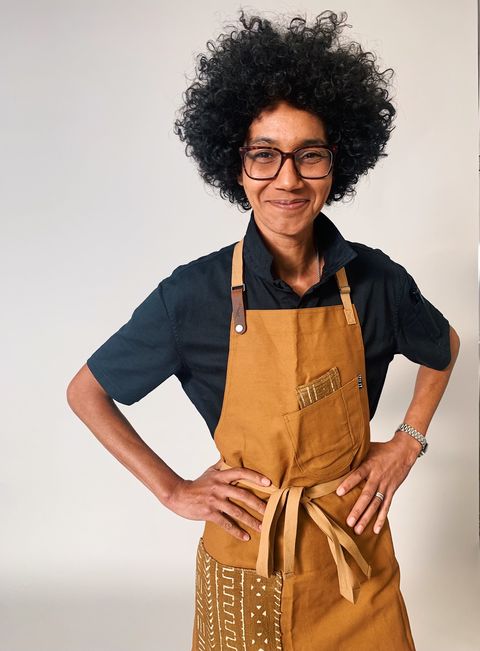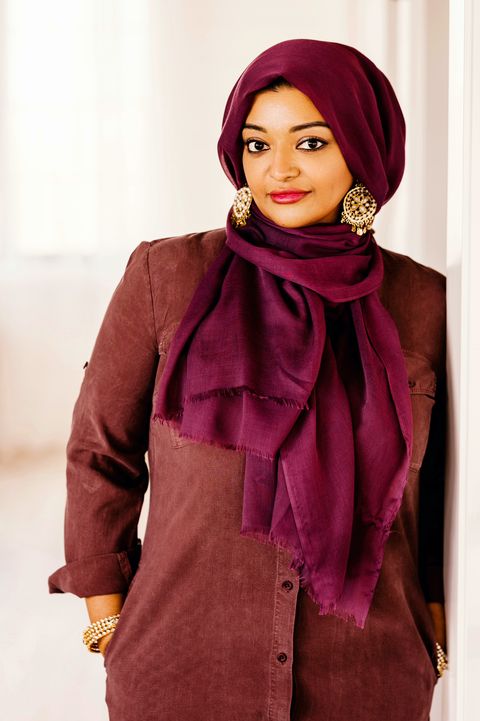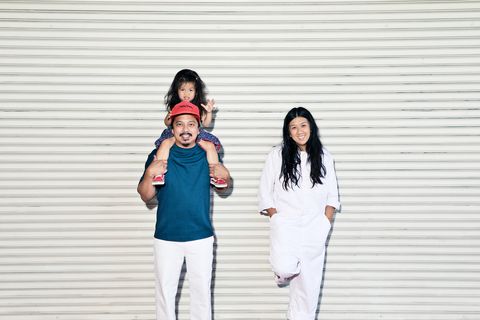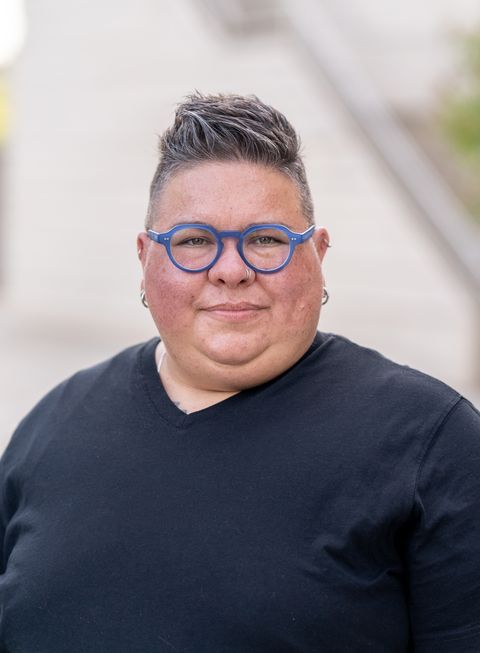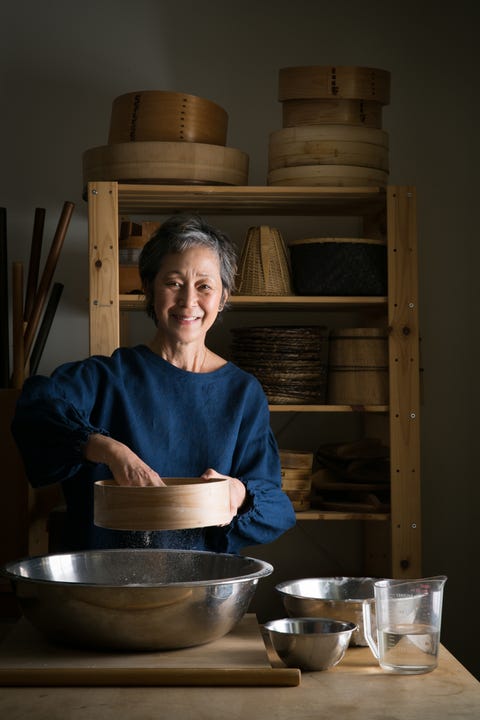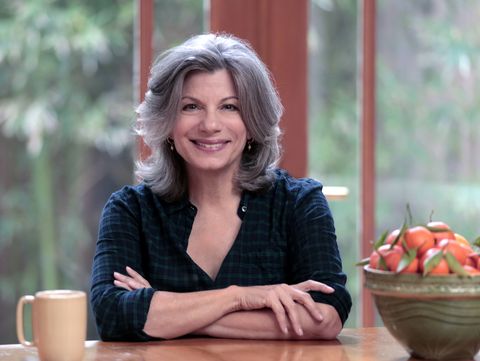This month at Shondaland, we’re celebrating once again what the holidays mean to all with our Food, Family, and Traditions series. These snapshots and vignettes from many of our beloved Shondaland stars, pals, and fans festively affirm the importance of communities both big and small coming together to celebrate.
Holiday traditions. We all have them. And like so many important life moments, these events are shaped and influenced by particular dishes and symbolic ingredients. These foods and flavors define our celebrations, adding layers of spice to the memories we take from them.
Growing up, my petite German grandmother, the matriarch of the family, insisted that ham be served at every major holiday and gathering, from weddings to christenings, Easter, Christmas, and New Year’s. She even brought a ham to our house once on Thanksgiving, daring everyone at the table to eat “that dry bird” instead. (We knew better; the untouched turkey my mother, her daughter, made was saved for leftovers.) Thankfully, not every family event was quite the showdown.
In the years since, my own family unit has developed holiday traditions of our own, the most famous being our “Long Table Thanksgiving.” For 18 years, this simple tradition has done a lot to minimize the holiday stress. We provide an array of birds (smoked, deep-fried, and turducken — and definitely not dry), and everyone else brings a dish to share with the group. And of course, we eat at a very long table.
Like so many traditions, the Long Table didn’t start out fully formed. It grew organically, evolving over the years. As a gay couple, my partner, Valerie, and I were conscious of friends who might not have welcoming family to go to for the holidays. Living in the melting pot that is Los Angeles, we knew many couldn’t afford to go home. So, everyone is invited to the house, with instructions to bring any stray friends and acquaintances. What started initially as a busy gathering around the family dinner table grew over the years, spilling outside to rented tables lined up along our very long driveway; hence the name.
Our Long Table has been described as a mixture of Norman Rockwell meets Fellini, with dishes ranging from Velveeta-laced casseroles and Texas barbecue to Kurdish lamb stews, Russian borscht, Southern Thai curries, and Oaxacan moles. The faces who grace our communal table straddle all religious, political, and gender divides. Guests may start out as strangers, but by the end of the evening, we’ve bonded, sharing cherished foods and stories that speak of home, our backgrounds, passions, and similarities.
I spoke with a number of friends and heroes of mine about the significance of food and its role in holiday traditions. We chatted about how traditions are indelibly shaped by a mishmash of family, friends, and dishes. We explored the importance of symbolism and recipes, as well as how we use each of these to reflect on our own history and narratives. And in a world that feels as divided as ever, it never ceases to amaze me how food can bridge even the widest gaps.
Zoe Adjonyoh
Zoe Adjonyoh is a writer, chef, and food justice activist seeking to positively influence the food landscape and further popularize African cuisine. Through her online single-origin spice shop, teaching, and cooking, Adjonyoh seeks to inspire African food entrepreneurs, home cooks, and chefs from the continent and diaspora. She is the author of Zoe’s Ghana Kitchen: An Introduction to New African Cuisine — From Ghana With Love.
Zoe Adjonyoh traces the importance of food in her life to 1977, when her Ghanaian father met her young Irish mother in Kilburn, North London. She was born in a convent for unmarried mothers. Her parents were poor, and she spent her formative years first in Ghana, and then back in England. “From a very young age, it was clear to me how important food was to both my parents in terms of nostalgia, comfort, and safety,” Adjonyoh recalls.
After moving to England, every available school holiday was spent in Ireland. “I had this juxtaposition of a concrete jungle in southeast London and then pretty much being like the only Black kid in the most remote part of West Cork. But that’s living an Irish life, you know?” she recalls. “Like fishing for salmon, and picking cockles and mussels off the beach, and farming, and all of the things that you might think of around there.”
Adjonyoh’s dad was often absent throughout her childhood, and without Ghanaian family in London, her African ancestry was largely shrouded in mystery. “When my dad was around in my life, I always remember him bringing either a bag of presents and/or a bag of food. And most of the time, he’d have a bag of food, things like shito [hot pepper sauce] or dried tilapia,” she says. “We’d have all of these ingredients that were incredibly different in terms of texture, flavor, and smells. You know, when you’re a child, you’re open, and that’s so exciting, and you’re able to be curious.”
He would cook for himself, and young Zoe would watch, curious about everything and fascinated by the journey he seemed to take preparing food. “It was meditative. And I understood that was his food from home, and that was his connection to home. He’s a very quiet man, and it was hard to get anything out of him, and the only access I could find to him was through food.”
Different as they might seem at first, Ghanaian and Irish culture have quite a few things in common, Adjonyoh notes. “There’s a very strong sense of spirituality, largely through Christianity. There is an emphasis on large families, as well as hospitality: family being together around the table, feeding people, making sure people have enough food, and having food available for anybody that might turn up on the doorstep at any time,” she notes. “The grandmother, or matriarch, is the boss. There are the storytelling traditions and the music.
“Ironically, for me, growing up gay with an Irish mother and Ghanaian father, we followed the generic English traditions more than anything. Now, I’m married to a Jewish-Hungarian-Italian New Yorker. And so, now I have Thanksgiving in my celebration calendar. Now I have Hanukkah and all of the Jewish holidays and celebrations,” Adjonyoh chuckles. “And so, what do all of those things look like? They look like they sound, a mash-up of all of the different cultures being present and celebrated.”
Adjonyoh shares a recipe for cubeb-spiced shortbread in her cookbook, the pepper being almost a great gateway spice to learning about Ghanaian flavors. “Using a simple flavoring like cubeb in shortbread, it’s not a frightening concept for people. It’s very simple. It’s like this wonderful spice, and the results are fantastic.” That, and the cookies are incredibly easy to make. “You know, people aren’t going to be scared of the heat, and they won’t be scared of whatever they have in their mind as a barrier [to Ghanaian flavors]. When they try it and then they get to experience a new flavor, this makes them curious to use that flavor in other things.”
Rabia Chaudry
The author of Fatty Fatty Boom Boom: A Memoir of Food, Fat & Family, Rabia Chaudry — attorney, advocate, and podcaster — is also the executive producer of the HBO documentary The Case Against Adnan Syed, based on her New York Times best-selling book, Adnan’s Story.
Rabia Chaudry chuckles when describing the importance of food in Muslim holiday traditions. “Traditional Muslims don’t drink. We don’t dance. Any celebratory event is — has to be — around food. Just food, food, food. So, there’s no holiday that’s not complete without you thinking about what you’re gonna eat,” she says. “We have two Eids a year, and each one lasts three days. So, that’s three days of feasting. Even the month of Ramadan ends with three days of feasting.”
Born in Pakistan, Chaudry emigrated to the United States with her family and was soon inundated with American holidays. “Growing up in public schools, and everywhere, there’s no way to escape American holidays: Christmas, of course, and even Halloween.” And each one had food associated with it.
And so, they began to celebrate them. “Thanksgiving was an easy one. There’s no religious significance to it, other than just being thankful to God. And that’s part of our tradition anyway. And so, we started celebrating Thanksgiving a long time ago.” But Chaudry’s mother would not roast a turkey, basically because they’d never had one. “We always had roasted chicken, but it would be chicken roasted with all of our spices. And we would do the mashed potatoes with a gravy, and it always had cumin in it and some spices.
“Even then, we always still had to have a full array of Pakistani food to go with [the Thanksgiving meal],” Chaudry laughs. “That was the only way my parents felt like they’d actually eaten.
“So, my sister and I, we host Thanksgiving now, and we’re at the point where we all deep-fry the turkey. And we love the traditional Thanksgiving sides. We do the sweet potato with marshmallows and [other] traditional Thanksgiving foods, but we almost always have a tray of biryani with it. There’s just no way around it.”
Asked about her own children growing up in the States, Chaudry admits it’s a very different experience from her own childhood. “They celebrate them in a way that we never did. We were first generation, and there wasn’t enough of a community or opportunity for any public recognition.” Now, “with my kids, I can go to Etsy, or I can go online and buy Eid decorations. And I can decorate the house during Ramadan, which we didn’t grow up doing because it would’ve been so strange.”
Chaudry shares a number of Pakistani family recipes in her book, and while it’s not specific to any holidays, Chaudry offers a recipe for the Lahori fried fish she fondly talks about in the book. “I’m from the city of Lahore, and while I know that this is not a holiday food, it’s a winter food. Winter is when people eat seafood back home, especially fried fish and fish curries.”
Ken Concepcion
Ken Concepcion is a former chef and co-owns, along with his wife, Michelle Mungcal, the renowned Now Serving cookbook store in Los Angeles.
When I asked Now Serving cookbook store co-owner Ken Concepcion about important holiday food memories, his first thoughts go to when he worked as a chef in the kitchen of Wolfgang Puck’s Cut in Beverly Hills years ago. “When I think of Thanksgiving, I actually think of what we would do with my chef, mentor, and friend Ari Rosenson. One of the things we came up with was this family/staff meal the day before Thanksgiving, turkey enchiladas. We would make enchiladas for 60 people. And the whole kitchen and all the chefs would be involved.” The day before the holiday, the kitchen staff would sit down before opening and package up enchiladas for different departments, such as laundry and housekeeping, in the Beverly Wilshire Hotel in which the restaurant is located. Within a few years, this became a trusted tradition. “People would come up and be like, ‘Oh, you’re making enchiladas tomorrow, right?’ It was so much fun,” recalls Concepcion.
Concepcion and his wife, Now Serving co-owner Michelle Mungcal, are both first-generation Filipino American. And while their Thanksgiving celebrations are pretty traditionally American, they do like to shake things up a bit.
“Believe it or not, until the pandemic, I was never actually in charge of the turkey,” notes Concepcion. “We’d usually go to an aunt’s house to have Michelle’s grandmother’s turkey. But when Covid hit, we had to make do for ourselves. These last couple of years, I’ve been doing Samin Nosrat’s Buttermilk Spatchcock Turkey. It’s so easy, and the recipe is bulletproof.”
He continues, “Every once in a while, we’ll try something different. My wife, sister-in-law, and I made a bunch of stuff from Eric Kim’s Korean American cookbook, I think for Easter, which was really fun. Still, especially in these uncertain times, you kind of want something familiar that will help you feel comforted and safe.”
Asked about holiday cooking and cookbook recommendations for readers, Concepcion frequently recommends Nosrat’s Salt Fat Acid Heat, as well as J. Kenji López-Alt’s The Food Lab. “I just spoke with a guest who was asking about Thanksgiving, and we were talking about Sam Sifton’s great Thanksgiving book. I told her it was a helpful blueprint because Sifton basically breaks down the whole week prior to Thanksgiving for you. It’s almost like you’re just counting down and executing,” Concepcion laughs, “to use the terms we’d say in the professional kitchen.”
Roberto Che Espinoza
Dr. Roberto Che Espinoza is a transqueer activist, Latinx scholar, and theologian. He is the founder of the Activist Theology Project, a collaborative endeavor committed to the collective work of social healing. He is the author of Body Becoming: A Path to Our Liberation.
Roberto Che Espinoza grew up in Texas but spent his summers in Mexico, exploring his Oaxacan roots. Food was an important part of his life, particularly during the holidays, and he especially remembers the blending of culinary traditions. “There was always an array of food during the holidays. Not only were there the Mexican folks, but there were also the white Americans and folks who had immigrated into the States.
“On Thanksgiving, we always had ceviche, and then a bunch of Mexican food, and then turkey and all the fixings. And then for Christmas, we would have traditional Mexican food on Christmas Eve: tamales, frijoles [beans], arroz [rice], and flan. Christmas day, we’d have white people’s food. So again, there was this multiplicity of events, multiplicity of food, and diversity of food,” he recalls.
“I always loved — let me say that as a person who knew that I was different sexually and gender-wise — [how] having those mixed experiences culturally helped me to also know that the differences I was feeling in my body were also okay.” Espinoza credits the sheer variety of foods, and their proud display at the holiday table, as what probably set him on his journey of scholarship exploring people’s differences, and how those differences can actually bring groups together and make us whole.
For Espinoza, “Food has always been a big part of my understanding of how we can be better humans.”
Espinoza is also conscious of hospitality and how, since ancient times, food has played an integral role in this important ritual. “I think food has been central to the politics of connection. In my work, I have used food as a way to connect with like-minded people, and to connect with different people. Like I always say, it’s hard to hate somebody over good food.
“I think one of the things that we’re really struggling with is that after being so isolated during the pandemic, we are learning to reconnect. And I think we are all learning how deeply we need to be connected with one another. And I think food is one of the mechanisms that can really foster that connection.”
Sonoko Sakai
Sonoko Sakai is a cooking teacher, noodle maker, food writer, and grain activist. She is the author of Japanese Home Cooking: Simple Meals, Authentic Flavors, as well as Poetical Pursuit of Food: Japanese Recipes for American Cooks and Rice Craft.
Sonoko Sakai credits her upbringing to a tapestry of experiences and influences, from her childhood spent in Japan, Mexico, and the United States to her Catholic upbringing and celebration of both Christian and Buddhist holidays.
“My father worked for Japan Airlines, and he was assigned to work in Mexico. So, I spent my first through fourth grade there. Living in Mexico, Christmas is so important, and it’s a longer celebration period. So at Christmas, I bring out the Nativity set, and it’s time for tamales,” Sakai laughs. “It’s a richness of traditions.”
For Sakai, it’s the gatherings on the holidays that are most special. “My whole motto about home cooking is that it’s nice to make really good food, but when I get people together, it’s about us coming together as a unit. And that’s what I find really important.
“Once a year, I get my sisters and their families together. My son flies out from Seattle, and we do a New Year’s [American calendar] celebration where we make food — it’s like a potluck.” Sakai explains that it’s even more important to celebrate New Year’s than Christmas for Japanese people because this is the turning of the page to a new calendar year, a way to welcome a fresh start. “It’s probably one of the most important holidays for me. But I make special foods for it too — good-luck foods that have a lot of symbolic meaning.”
Sakai continues, “At the end of the year, we eat noodles. I make soba noodles for longevity, and we always eat them on New Year’s Eve to kick off the new year. We also eat mochi, and it’s important because mochi is the symbol of flexibility and elasticity. Especially coming out of the pandemic or even during the pandemic, we wanted to be able to endure the hardship. If you’re flexible, you don’t break.” She laughs. “That’s the kind of message we take in when we eat these special foods.”
Amelia Saltsman
The daughter of a Romanian mother and an Iraqi father, Amelia Saltsman was born and raised in Los Angeles. Her cooking is inspired by her eclectic background, with the diverse flavors and cultural touchstones that have made her award-winning first book, The Santa Monica Farmers’ Market Cookbook, a classic. She is also the author of The Seasonal Jewish Kitchen: A Fresh Take on Tradition.
Amelia Saltsman’s parents came to the United States about six months before she was born, settling in California. And while both met and emigrated from Israel, their traditions were vastly different: Saltsman’s father was Iraqi, and her mother was Romanian. This combination of Middle Eastern and European influences would help to shape Saltsman’s interest in and passion for ingredients, food history, and culinary traditions.
“I’m multicultural. And the thing that’s interesting about this, I think, is I’m not unique, really,” she notes. Dishes develop, and holiday traditions evolve often as a kind of hodgepodge, but with purpose. “This multicultural experience is impacted not only by the blending of family but also where we live. If we bring that to food and the history of food, you see traditions develop first based on where people are, and what was available, and what cooking techniques existed. After that, you kind of apply religious or cultural interpretations to these things.”
Saltsman considers the traditions of Christmas and Hanukkah and their proximity to the winter solstice. There are colorful Christmas lights and the lighting of the Christmas tree. And Hanukkah is known as the Festival of Lights.
“Hanukkah begins on the dark moon closest to the winter’s solstice. And the same is true of Christmas when it started. And looking back historically in the Middle East and in Israel, olive oil was big business and one of the most important crops for thousands of years,” Saltsman notes.
“One way of looking at Hanukkah is that it’s a celebration of the olive oil harvest — olio nuovo — and that hasn’t changed. And so, every Jewish culture typically celebrates by frying something.” You have potato pancakes, or latkes. Though these could also be — and have been historically — made with a variety of other root vegetables.
“Beyond latkes, the Iraqi Jews might fry zengoula, and the Spanish Jews might fry buñuelos. Polish Jews might do Pączki or sufganiyot [jelly doughnuts]. At the end of the day, it’s about celebrating the oil,” notes Saltsman. Zengoula is essentially a funnel cake and is a thousand-year-old Iraqi tradition. “My grandmother made zengoula as the family’s Hanukkah tradition. They’re light and crispy, with a mixture of cornstarch and flour. And the Meyer lemon syrup — Meyer lemons are in season now — gives just the right floral sweetness and tang.
“And what an extraordinary coincidence, and especially for all of us today. Sometimes we lose touch with the symbolism or tradition — ‘I don’t do that anymore!’ — but it’s how we connect what we see in front of us today with the reason behind it from ancient times. These traditions are not disconnected, and they’re not silent,” stresses Saltsman.
Noelle Carter is a chef, food writer, and culinary consultant. She was the longtime test-kitchen director and food writer at the Los Angeles Times and a contributor to The Splendid Table radio series. Follow her on Twitter @noellecarter.
Get Shondaland directly in your inbox: SUBSCRIBE TODAY
Credit: Source link



